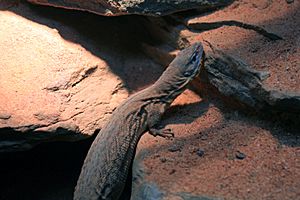Storr's monitor facts for kids
The Storr's monitor (Varanus storri) is a type of monitor lizard. It belongs to the Varanidae family. This lizard is special because it only lives in Australia.
Quick facts for kids Storr's monitor |
|
|---|---|
 |
|
| Varanus storri | |
| Conservation status | |
| Scientific classification | |
| Genus: |
Varanus
|
| Species: |
storri
|
Contents
What's in a Name?
The Storr's monitor gets its name from a famous Australian scientist. His name was Glen Milton Storr. He studied reptiles and amphibians.
Different Kinds of Storr's Monitors
There are two slightly different types, or subspecies, of Storr's monitors:
- Varanus storri ocreatus
- Varanus storri storri
Where They Live
Storr's monitors live in warm, wet parts of Australia. They especially like rocky places. The V. storri storri lives in eastern Australia. You can find it from Charters Tower to Queensland. The V. storri ocreatus mostly lives in Western Australia and the Northern Territory. Both types live in similar climates and homes. They can be found in open woodlands, grasslands, and rocky areas. They also live in areas with spiky spinifex grass.
What They Look Like
The Storr's monitor is smaller than the similar-looking spiny-tailed monitor. It also has duller colors. These lizards grow to be just over 40 cm (1.3 ft) long. This measurement includes their tail. The V. s. ocreatus has a longer tail and legs. Its tail is about 1.6 times longer than its body. The V. s. storri's tail is only about 1.4 times longer than its body. The V. s. ocreatus also has bigger scales on the bottom of its back legs. Both male and female Storr's monitors look very similar. It's hard to tell them apart just by looking.
How They Behave
Storr's monitors mostly stay on the ground. They don't climb trees very often. These lizards often live in groups, like a colony. Up to 50 monitors might live in an area of about 0.75 square kilometers. Each monitor has its own burrow. They dig U-shaped tunnels under large rocks or spinifex grass. Sometimes, they wave their tails at each other. Storr's monitors are most active in the mornings and late afternoons. This happens between February and March, and again from July to November. They go into their burrows during the hottest parts of the day. Unlike bigger monitors, they stay active even when it's cooler. They only slow down during the cold winter months.
Reproduction and Life Cycle
Storr's monitors can start having babies when they are about 9 cm (3.5 in) long. This is measured from their snout to their vent (SVL). Male monitors are ready to breed throughout the year. But they are most active in November. This is during the late dry season and early wet season. Female monitors can also lay eggs all year round. They lay up to 6 eggs at a time. The eggs are kept warm at about 27–29 °C (81–84 °F). They hatch after 100 to 129 days. Young monitors can become parents themselves about 18 months later.
What They Eat
Storr's monitors mostly eat insects and other small creatures. They especially like grasshoppers and crickets. They also eat ants, beetles, and spiders. Sometimes, they even eat other lizards like skinks and geckos. Their diet changes with the seasons. They eat a lot during most of the year. This helps them build up fat. These fat reserves help them survive the winter months when they are less active.


